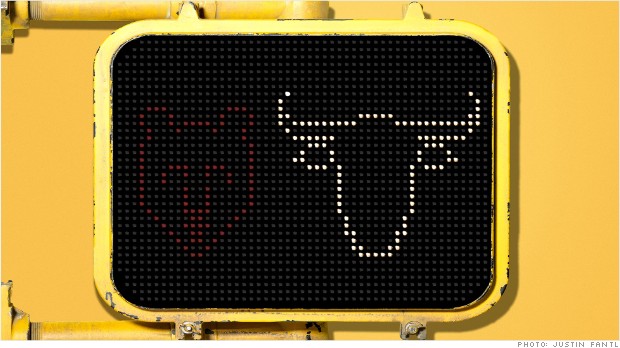
Three key market indicators are flashing caution.
(Money Magazine)
Not that a decline is totally unexpected: Total returns for the Standard & Poor's 500 have tripled in the past five years -- that's a year longer than the average bull run -- and stocks have seemed due for a fall. Indeed, in our annual Investor's Guide, MONEY warned of tough sledding ahead.
Still, bull markets have been known to defy the odds and linger long past their expected expiration date. Even the January indicator has been wrong four times out of 10 when it comes to predicting market drops -- witness this year's market bounce-back in February.
How, then, can you tell whether stocks' earlier setback signals the end of the bull market or is merely a pothole on the road to higher prices? The following indicators have proved to be among the most accurate over time.
Revenues are key
Stock valuations shot up last year in anticipation of a strengthening economy and growing corporate profits. And earnings did improve, rising just shy of 15% in 2013 for S&P 500 companies.
That stellar outcome, however, didn't reflect true strength in the underlying businesses -- revenues last year inched up 2.6%. Instead, earnings per share were partly inflated by cost-cutting initiatives and stock buybacks that reduced the number of shares outstanding, as companies took advantage of Fed-engineered low-rate financing.
Related: Stocks, bonds? In 2014, think cash
For the market to keep advancing, says BMO Private Bank chief investment officer Jack Ablin, profits going forward need to be driven mostly by rising revenues.
Indicator to watch. Track S&P 500 revenues using the price-to-sales ratio (go to multpl.com). At 1.6, the P/S is now 15% above its historical average. Traditionally that's been more likely to signal subpar returns ahead than a market drop: Since 1993, in the three years following a reading of 1.6, stocks have eked out average annual gains of 1%, says Ablin.
When to really worry. A P/S of 2 would be "a huge red flag" says Ablin. When the P/S peaked at 2.3 in early 2000, he notes, stocks lost 44% over the next three years.
See who's at the party
When a bull has nearly run its course, fewer and fewer stocks participate in the rally, and new market highs are powered by a small number of companies. That was another warning in the year leading up to the dotcom bust of 2000: Only about 50 holdings drove the S&P 500's record returns.
Indicator to watch. The advance-decline line tracks the number of stocks rising and falling, moving up when more stocks gain than lose. It typically peaks three to six months before a downturn, says James Stack, president of the InvesTech newsletter. For most of last year advances far outnumbered declines, but lately the reverse has been happening.
When to really worry. Sound the alarm bells if the advance-decline line moves in a different direction from market indexes -- a phenomenon, known as divergence, that has proved even more telling than movements in the AD line alone, says wealth manager Barry Ritholtz.
Related: How to take a stock loss on your taxes
In both 1973 and 1980, for example, the markets saw major divergences before crashes. Ritholtz points out, though, that so far this year the AD line has moved largely in line with the indexes.
Beware of overconfidence
"Be fearful when others are greedy," Warren Buffett has famously said. It's a reference to investors' rotten record of market timing, with many historical examples (1990, 1999, and 2007, just to name three) of them piling into stocks just before a precipitous price drop. That's why analysts often view investor sentiment as a contrary indicator.
Indicator to watch. The American Association of Individual Investors tracks bearishness among its members on a weekly basis (aaii.com/sentimentsurvey). At the end of last year AAII found that only 18.5% of investors were bearish, vs. a long-term average of 30.5%. Typically the market has delivered underwhelming returns the year after such a reading, but not losses.
When to really worry. Six of the nine times since 1987 that bearishness fell below 10.5%, stocks slumped within six months, says AAII's Charles Rotblut, losing 15% over the next year. If that happens, bearishness will no doubt spike, and you can follow the other half of Buffett's advice: "Be greedy when others are fearful." ![]()
First Published: March 3, 2014: 4:16 PM ET
Anda sedang membaca artikel tentang
Heed these market signs
Dengan url
http://brokolsayuransehat.blogspot.com/2014/03/heed-these-market-signs.html
Anda boleh menyebar luaskannya atau mengcopy paste-nya
Heed these market signs
namun jangan lupa untuk meletakkan link
sebagai sumbernya
0 komentar:
Posting Komentar